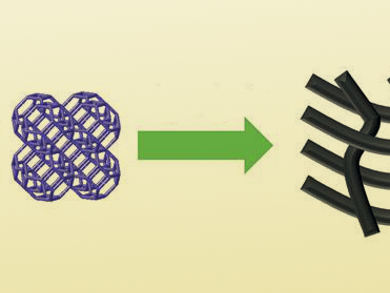Manipulating graphitic carbon nanoparticles into three-dimensional networks is useful because these structures have great potential in electrical energy conversion and storage. However, there are few methods that can be used to connect the graphitic carbon nanoparticles into networks.
Ming Hu, East China Normal University, Shanghai, and colleagues have developed a strategy to weld graphitic carbon nanoparticles together into networks. They found that a spontaneous weaving of the networks could be triggered by annealing cobalt-containing metal–organic frameworks (ZIF-67) with a size less than 100 nm.
The annealing process generates cobalt nanoparticles that are believed to be the nodes that connect carbons together through catalytic graphitization. This simple method produces carbon networks with excellent electrochemical performance as anodes for potassium-ion batteries.
- Spontaneous Weaving of Graphitic Carbon Networks Synthesized by Pyrolysis of ZIF-67 Crystals,
Wei Zhang, Xiangfen Jiang, Xuebin Wang, Yusuf Valentino Kaneti, Yinxiang Chen, Jian Liu, Ji-Sen Jiang, Yusuke Yamauchi, Ming Hu,
Angew. Chem. Int. Ed. 2017.
DOI: 10.1002/anie.201701252




